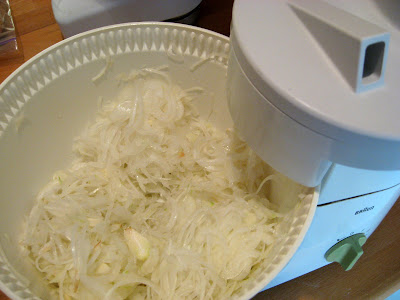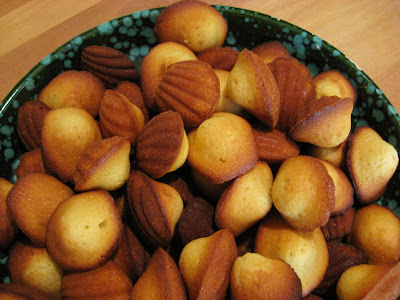Saturday morning I leapt onto the little balcony of my kitchen, gasping for air, crying like a lost child. Tears and snot were running down my face and I had to grab the railing just to keep standing straight.
Most embarassingly, said balcony is on ground level, a pygmy porch really, and right next to our neighbour's garden. Of course, said neighbour was just out, fixing some corners of the pavement, and was now staring at me with that certain blank expression.
"Morning..." he said, choosing his words carefully, the way people normally do when dealing with other people covered in blood and wielding sharp objects. "Hay fever...?" he asked cautiously.
He's a sweet guy, though not a man of many words. As I was still struggling to regain my composure, all I could do was shake my head, which did little to restore my sanity in his eyes. Finally, after wiping my face with my t-shirt, I managed to get my head straight enough to reply.
"No. Onion soup."
Our neighbour just smiled politely, nodded and walked away. You know, that moderately swift, very inconspicous kind of walking away.
Poor guy.
I mean, it's probably not easy for them. Their house is build on the rear end of their lot, and basically every time they go anywhere, they have to pass right next to our kitchen. And in summer, our kitchen door onto the little balcony is always open.
So they have the questionable pleasure of being forced to witness stroboscopic snapshots of our life as it happens in the kitchen, or on the balcony respectively.
Somehow it always seems to be the guy standing around when I do something that looks especially eccentric, taken out of context as it is. Like dusting all the flowers with flour, or washing a hundredweight potatoes in a pink plastic tub or things like that. And just don't get me started on the burning pan...
This weekend, he learned that in my household, making onion soup apparently is an activity that entails military grade ABC hazards.
So what, he'll get over it. I did too, though I admittedly needed the help of a very dry Dry Martini. Well, maybe he did, too.
Onion soup has always been a staple in my family, growing up with francophile parents as I did. And it is dead easy to make, so it actually was one of the first proper recipes I added to my repertoire as a kid.
It is a simple hearty dish, yes, but with such a complex flavour that is rightly has its place among the great kitchen classics. At least that is what I am convinced of.
I especially like onion soup in summer, even though it's a rather warming dish. But it is a markedly assertive vegetarian option for a light summer dinner, filling yet not stuffing.
And by the way, concerning that other ABC hazard many people are concerned about when dealing with a lot of onions - I have never had that happen with anything made from fresh onions, nor do I know anyone. Maybe it's got something to do with the preservatives in pre-roasted onions. Or maybe something else entirely. Whatever the reason, as far as I can tell this soup is perfectly sociable. Apart from the teensy little bit of garlic, that is...

onion soup
(serves four)
about 1 kg onions
2 cloves garlic
100g butter
2 tablespoons flour
1 teaspoon sweet paprica
1/2 teaspoon ground anisseed
1/2 teaspoon thyme
cayenne pepper to taste
500ml dry white wine
750ml stock or water
crusty white bread
250g mild cheese (minimum!), like Gouda, Greyezer or Fontina, grated
Peel the onions and cut into fine rings (or rather half-rings, for that matter). Peel and chop the garlic, or just throw into the vegetable slicer with the onions.
Usually, I have no problem cutting onions. Breathe in trough the mouth, out through the nose, and don't let the onion get close to your eyes. But this time, the combination of a still-lingering cold and the fact that I barely ever use my kitchen mixer's vegetable slicer for cutting onions made me drop my caution. All was fine while slicing the onions, but when I opened the thing to clean it, I got a whole whopping lung full of onion mist, and it worked like teargas. Hence me scaring our neighbour, again.
At least the cold was truly gone afterwards.

In a large pot, melt the butter over medium heat and add the onions. Boil until the moisture has evaporated, but make sure not to brown the onions. Reduce to low heat and simmer until very soft and fragrant, while stirring occasionally.
If you want, you can go all the way here and caramelize the onions in this step. That is, continuing to gently simmer them until they are brown(ish) and really sweet, without ever letting them get too hot else they would burn. This adds some more taste, but I can't find any real difference in the finished soup as long as the onions have had enough time to simmer on their own.
Add the flour and the spices, stir and simmer for a few more minutes.
Turn up the heat and add wine and stock, if you use water you might want to add some salt.
This recipe gives the wine / water ratio I prefer, but it works nicely with pure wine as well. Though I can't imagine the recipe working with water only... A shot glass of pastis or another strong anise liquor can be added at this stage for added complexity - if you like anise.
Bring to boil, then reduce heat and leave to simmer. Cook until the alcohol has evaporated, and the soup tastes sweet and harmonious, at least an hour, though longer is better here.
This is one thing that never fails to amaze me. The difference such a long cooking time makes is stunning especially as it is just time you add, no special ingredient. Well, then again, maybe time IS the special ingredient here. But it harmonizes the strong flavours of the soup, turning it from so-so to nom-nom.
I usually prepare this dish late morning, then leave it to simmer until I return into the kitchen for an afternoon tea. So I'd say, three or four hours simmering would be optimal.
Right before serving, heat up the grill of your oven. Slice the bread and toast lightly with some butter until crisp.
Distribute the soup into ovenproof bowls, put the bread on top and cover with cheese. Run under the very hot grill until the cheese is molten and bubbly, then serve immediately.
Can be served in small portions as a starter, or as given in this recipe, as a moderate main. Goes perfectly with most dry white wines.










